Information Systems and Business: A Report on the Lego Group (MIS101)
VerifiedAdded on 2022/08/21
|9
|2213
|18
Report
AI Summary
This report provides a comprehensive analysis of the information systems implemented by the Lego Group, a major player in the toy manufacturing industry. The study focuses on how the company utilizes SAP business software, specifically its ERP modules such as SCM, PLM, and HCM, to manage its operations, supply chain, and product lifecycle. The report delves into the architecture of the SAP system, including its three-tier client-server structure and the various components like hardware, software, databases, and networks. It also examines the security elements critical for protecting the company's data and the network components that support the system. The discussion highlights the advantages of using SCM for production planning, ERP for streamlining business processes, and PLM for managing product lifecycles. Furthermore, the report offers recommendations for further improvements, such as incorporating performance measurements, implementing CRM modules, and integrating marketing automation. The conclusion summarizes the key findings, emphasizing the effectiveness of SAP in enhancing the Lego Group's business operations while acknowledging areas for future development.
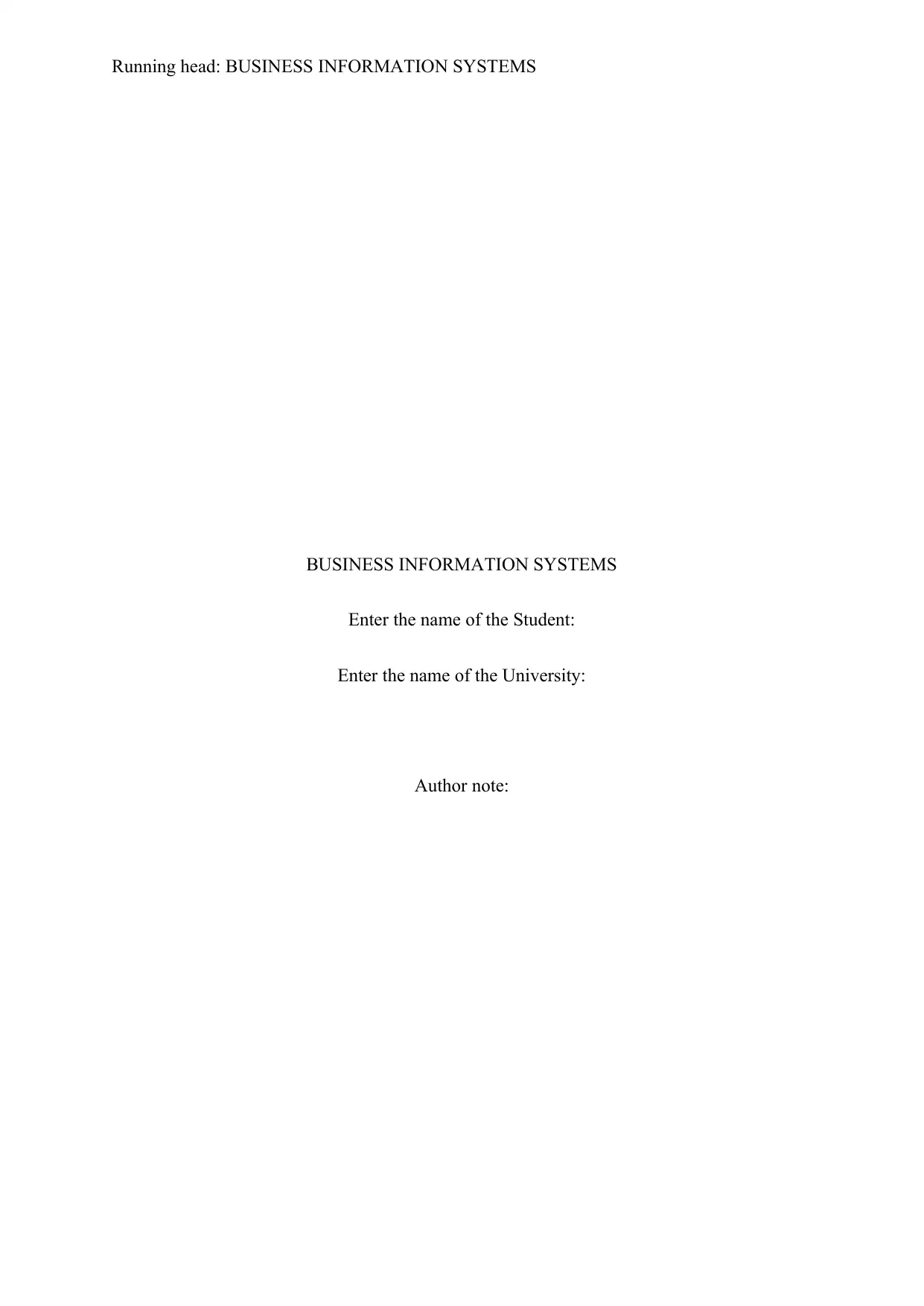
Running head: BUSINESS INFORMATION SYSTEMS
BUSINESS INFORMATION SYSTEMS
Enter the name of the Student:
Enter the name of the University:
Author note:
BUSINESS INFORMATION SYSTEMS
Enter the name of the Student:
Enter the name of the University:
Author note:
Paraphrase This Document
Need a fresh take? Get an instant paraphrase of this document with our AI Paraphraser
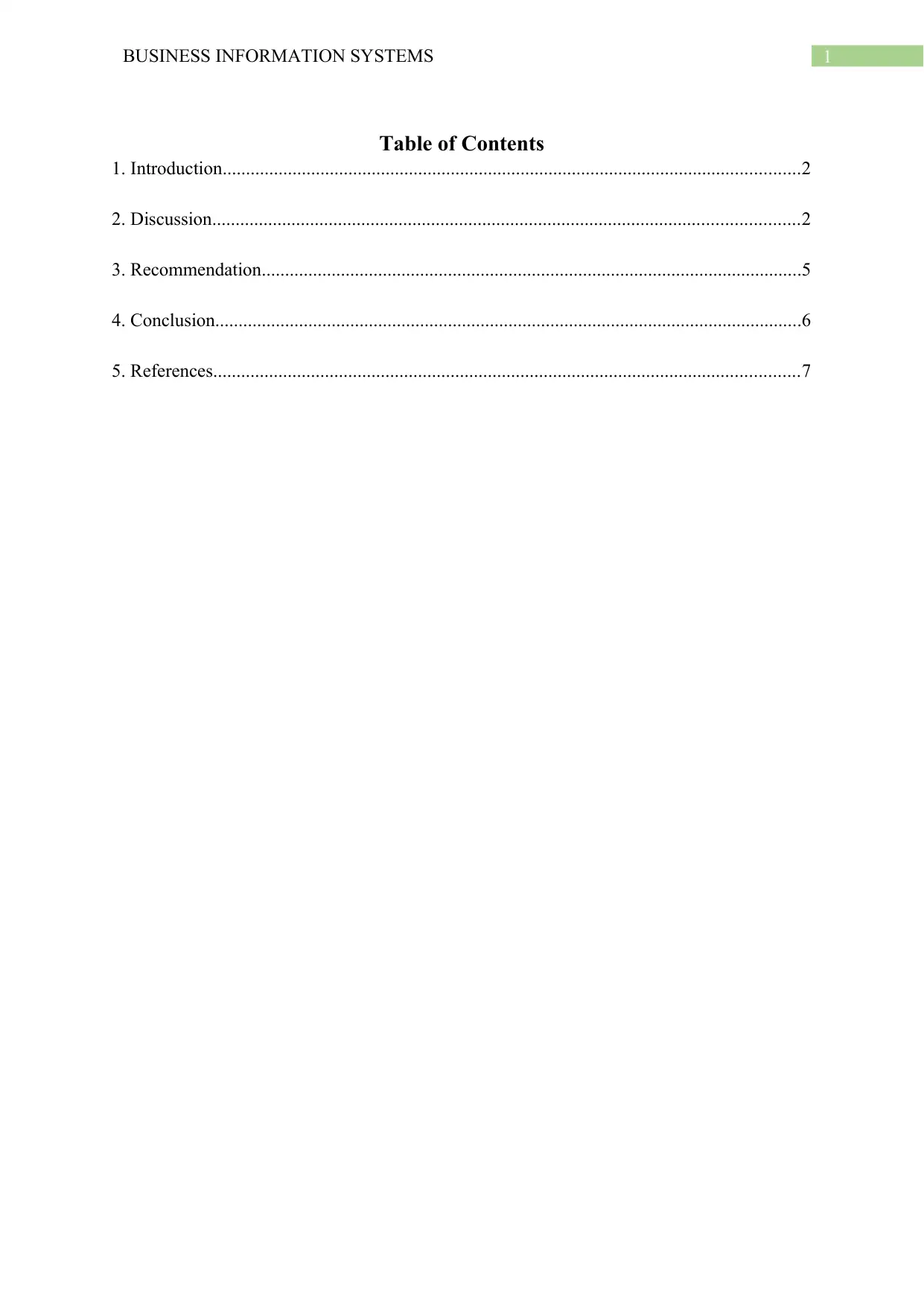
1BUSINESS INFORMATION SYSTEMS
Table of Contents
1. Introduction............................................................................................................................2
2. Discussion..............................................................................................................................2
3. Recommendation....................................................................................................................5
4. Conclusion..............................................................................................................................6
5. References..............................................................................................................................7
Table of Contents
1. Introduction............................................................................................................................2
2. Discussion..............................................................................................................................2
3. Recommendation....................................................................................................................5
4. Conclusion..............................................................................................................................6
5. References..............................................................................................................................7
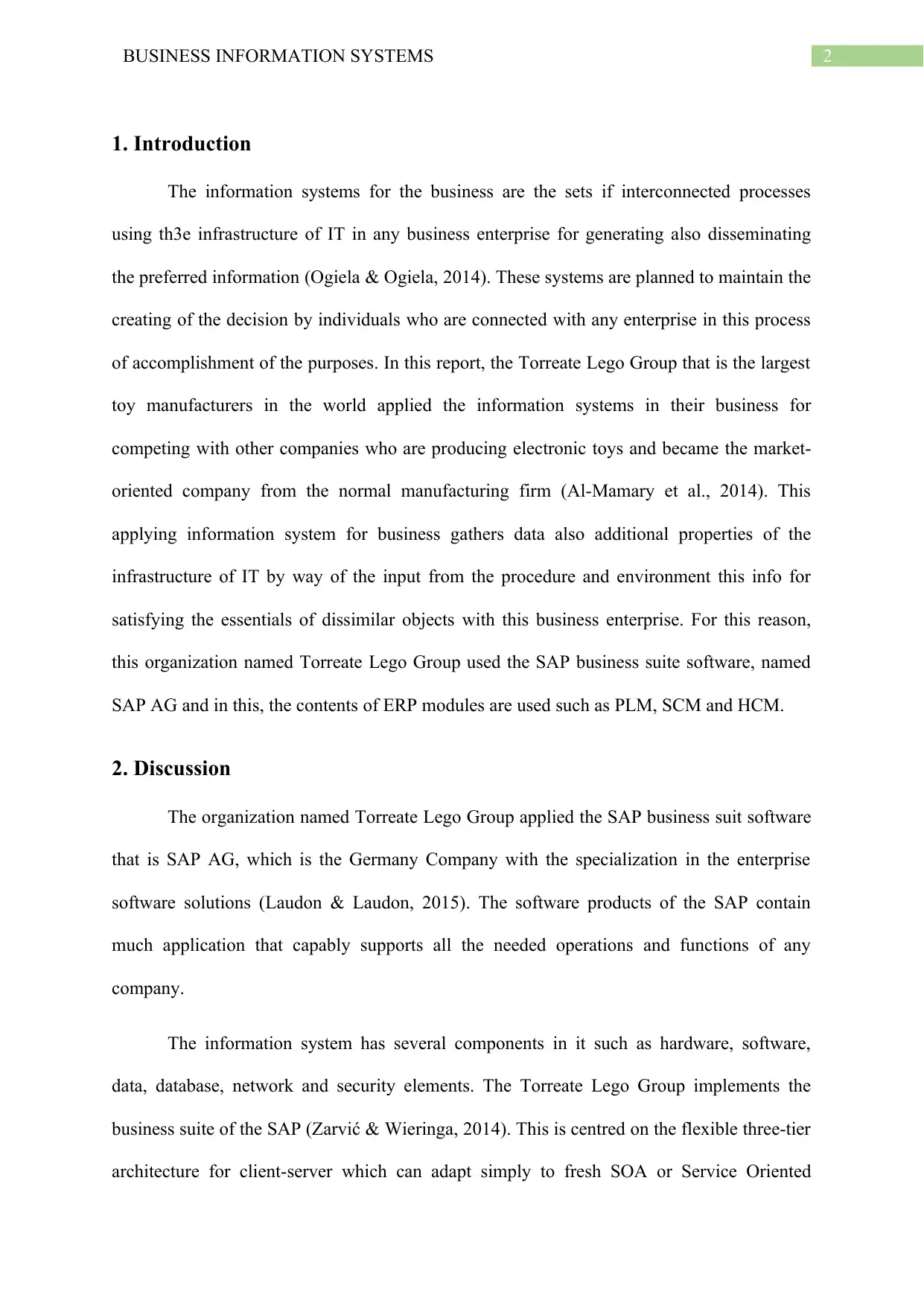
2BUSINESS INFORMATION SYSTEMS
1. Introduction
The information systems for the business are the sets if interconnected processes
using th3e infrastructure of IT in any business enterprise for generating also disseminating
the preferred information (Ogiela & Ogiela, 2014). These systems are planned to maintain the
creating of the decision by individuals who are connected with any enterprise in this process
of accomplishment of the purposes. In this report, the Torreate Lego Group that is the largest
toy manufacturers in the world applied the information systems in their business for
competing with other companies who are producing electronic toys and became the market-
oriented company from the normal manufacturing firm (Al-Mamary et al., 2014). This
applying information system for business gathers data also additional properties of the
infrastructure of IT by way of the input from the procedure and environment this info for
satisfying the essentials of dissimilar objects with this business enterprise. For this reason,
this organization named Torreate Lego Group used the SAP business suite software, named
SAP AG and in this, the contents of ERP modules are used such as PLM, SCM and HCM.
2. Discussion
The organization named Torreate Lego Group applied the SAP business suit software
that is SAP AG, which is the Germany Company with the specialization in the enterprise
software solutions (Laudon & Laudon, 2015). The software products of the SAP contain
much application that capably supports all the needed operations and functions of any
company.
The information system has several components in it such as hardware, software,
data, database, network and security elements. The Torreate Lego Group implements the
business suite of the SAP (Zarvić & Wieringa, 2014). This is centred on the flexible three-tier
architecture for client-server which can adapt simply to fresh SOA or Service Oriented
1. Introduction
The information systems for the business are the sets if interconnected processes
using th3e infrastructure of IT in any business enterprise for generating also disseminating
the preferred information (Ogiela & Ogiela, 2014). These systems are planned to maintain the
creating of the decision by individuals who are connected with any enterprise in this process
of accomplishment of the purposes. In this report, the Torreate Lego Group that is the largest
toy manufacturers in the world applied the information systems in their business for
competing with other companies who are producing electronic toys and became the market-
oriented company from the normal manufacturing firm (Al-Mamary et al., 2014). This
applying information system for business gathers data also additional properties of the
infrastructure of IT by way of the input from the procedure and environment this info for
satisfying the essentials of dissimilar objects with this business enterprise. For this reason,
this organization named Torreate Lego Group used the SAP business suite software, named
SAP AG and in this, the contents of ERP modules are used such as PLM, SCM and HCM.
2. Discussion
The organization named Torreate Lego Group applied the SAP business suit software
that is SAP AG, which is the Germany Company with the specialization in the enterprise
software solutions (Laudon & Laudon, 2015). The software products of the SAP contain
much application that capably supports all the needed operations and functions of any
company.
The information system has several components in it such as hardware, software,
data, database, network and security elements. The Torreate Lego Group implements the
business suite of the SAP (Zarvić & Wieringa, 2014). This is centred on the flexible three-tier
architecture for client-server which can adapt simply to fresh SOA or Service Oriented
⊘ This is a preview!⊘
Do you want full access?
Subscribe today to unlock all pages.

Trusted by 1+ million students worldwide
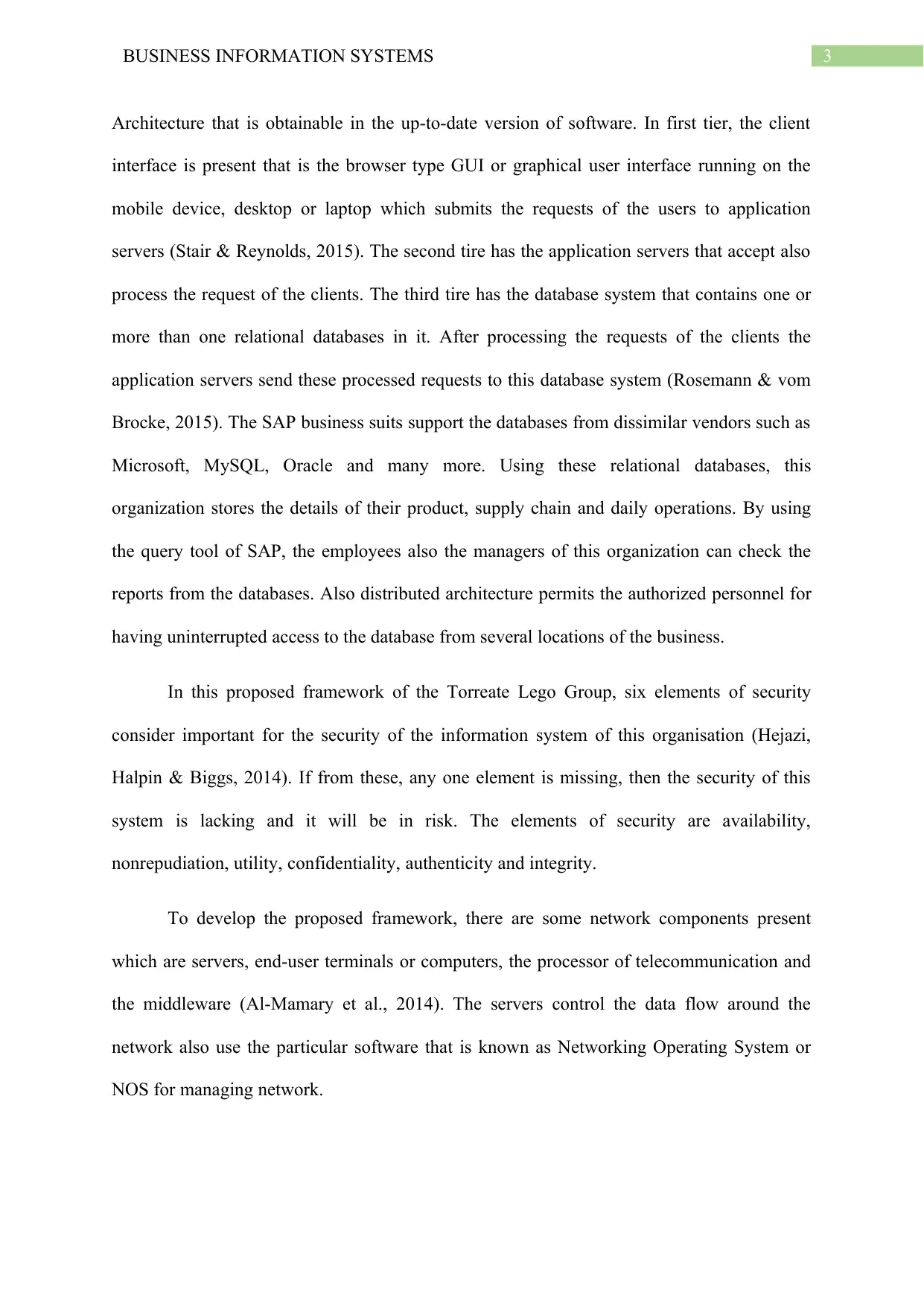
3BUSINESS INFORMATION SYSTEMS
Architecture that is obtainable in the up-to-date version of software. In first tier, the client
interface is present that is the browser type GUI or graphical user interface running on the
mobile device, desktop or laptop which submits the requests of the users to application
servers (Stair & Reynolds, 2015). The second tire has the application servers that accept also
process the request of the clients. The third tire has the database system that contains one or
more than one relational databases in it. After processing the requests of the clients the
application servers send these processed requests to this database system (Rosemann & vom
Brocke, 2015). The SAP business suits support the databases from dissimilar vendors such as
Microsoft, MySQL, Oracle and many more. Using these relational databases, this
organization stores the details of their product, supply chain and daily operations. By using
the query tool of SAP, the employees also the managers of this organization can check the
reports from the databases. Also distributed architecture permits the authorized personnel for
having uninterrupted access to the database from several locations of the business.
In this proposed framework of the Torreate Lego Group, six elements of security
consider important for the security of the information system of this organisation (Hejazi,
Halpin & Biggs, 2014). If from these, any one element is missing, then the security of this
system is lacking and it will be in risk. The elements of security are availability,
nonrepudiation, utility, confidentiality, authenticity and integrity.
To develop the proposed framework, there are some network components present
which are servers, end-user terminals or computers, the processor of telecommunication and
the middleware (Al-Mamary et al., 2014). The servers control the data flow around the
network also use the particular software that is known as Networking Operating System or
NOS for managing network.
Architecture that is obtainable in the up-to-date version of software. In first tier, the client
interface is present that is the browser type GUI or graphical user interface running on the
mobile device, desktop or laptop which submits the requests of the users to application
servers (Stair & Reynolds, 2015). The second tire has the application servers that accept also
process the request of the clients. The third tire has the database system that contains one or
more than one relational databases in it. After processing the requests of the clients the
application servers send these processed requests to this database system (Rosemann & vom
Brocke, 2015). The SAP business suits support the databases from dissimilar vendors such as
Microsoft, MySQL, Oracle and many more. Using these relational databases, this
organization stores the details of their product, supply chain and daily operations. By using
the query tool of SAP, the employees also the managers of this organization can check the
reports from the databases. Also distributed architecture permits the authorized personnel for
having uninterrupted access to the database from several locations of the business.
In this proposed framework of the Torreate Lego Group, six elements of security
consider important for the security of the information system of this organisation (Hejazi,
Halpin & Biggs, 2014). If from these, any one element is missing, then the security of this
system is lacking and it will be in risk. The elements of security are availability,
nonrepudiation, utility, confidentiality, authenticity and integrity.
To develop the proposed framework, there are some network components present
which are servers, end-user terminals or computers, the processor of telecommunication and
the middleware (Al-Mamary et al., 2014). The servers control the data flow around the
network also use the particular software that is known as Networking Operating System or
NOS for managing network.
Paraphrase This Document
Need a fresh take? Get an instant paraphrase of this document with our AI Paraphraser
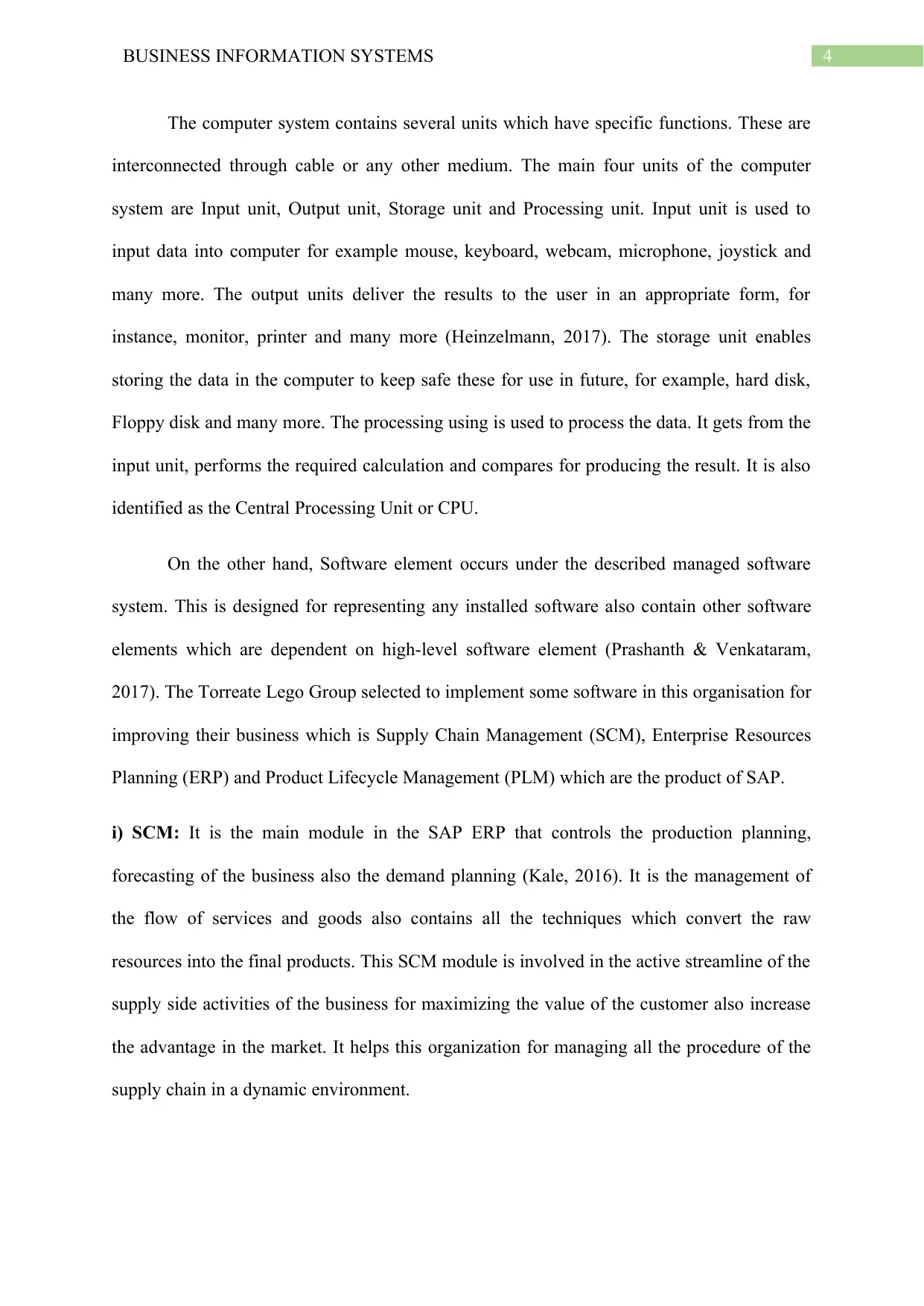
4BUSINESS INFORMATION SYSTEMS
The computer system contains several units which have specific functions. These are
interconnected through cable or any other medium. The main four units of the computer
system are Input unit, Output unit, Storage unit and Processing unit. Input unit is used to
input data into computer for example mouse, keyboard, webcam, microphone, joystick and
many more. The output units deliver the results to the user in an appropriate form, for
instance, monitor, printer and many more (Heinzelmann, 2017). The storage unit enables
storing the data in the computer to keep safe these for use in future, for example, hard disk,
Floppy disk and many more. The processing using is used to process the data. It gets from the
input unit, performs the required calculation and compares for producing the result. It is also
identified as the Central Processing Unit or CPU.
On the other hand, Software element occurs under the described managed software
system. This is designed for representing any installed software also contain other software
elements which are dependent on high-level software element (Prashanth & Venkataram,
2017). The Torreate Lego Group selected to implement some software in this organisation for
improving their business which is Supply Chain Management (SCM), Enterprise Resources
Planning (ERP) and Product Lifecycle Management (PLM) which are the product of SAP.
i) SCM: It is the main module in the SAP ERP that controls the production planning,
forecasting of the business also the demand planning (Kale, 2016). It is the management of
the flow of services and goods also contains all the techniques which convert the raw
resources into the final products. This SCM module is involved in the active streamline of the
supply side activities of the business for maximizing the value of the customer also increase
the advantage in the market. It helps this organization for managing all the procedure of the
supply chain in a dynamic environment.
The computer system contains several units which have specific functions. These are
interconnected through cable or any other medium. The main four units of the computer
system are Input unit, Output unit, Storage unit and Processing unit. Input unit is used to
input data into computer for example mouse, keyboard, webcam, microphone, joystick and
many more. The output units deliver the results to the user in an appropriate form, for
instance, monitor, printer and many more (Heinzelmann, 2017). The storage unit enables
storing the data in the computer to keep safe these for use in future, for example, hard disk,
Floppy disk and many more. The processing using is used to process the data. It gets from the
input unit, performs the required calculation and compares for producing the result. It is also
identified as the Central Processing Unit or CPU.
On the other hand, Software element occurs under the described managed software
system. This is designed for representing any installed software also contain other software
elements which are dependent on high-level software element (Prashanth & Venkataram,
2017). The Torreate Lego Group selected to implement some software in this organisation for
improving their business which is Supply Chain Management (SCM), Enterprise Resources
Planning (ERP) and Product Lifecycle Management (PLM) which are the product of SAP.
i) SCM: It is the main module in the SAP ERP that controls the production planning,
forecasting of the business also the demand planning (Kale, 2016). It is the management of
the flow of services and goods also contains all the techniques which convert the raw
resources into the final products. This SCM module is involved in the active streamline of the
supply side activities of the business for maximizing the value of the customer also increase
the advantage in the market. It helps this organization for managing all the procedure of the
supply chain in a dynamic environment.
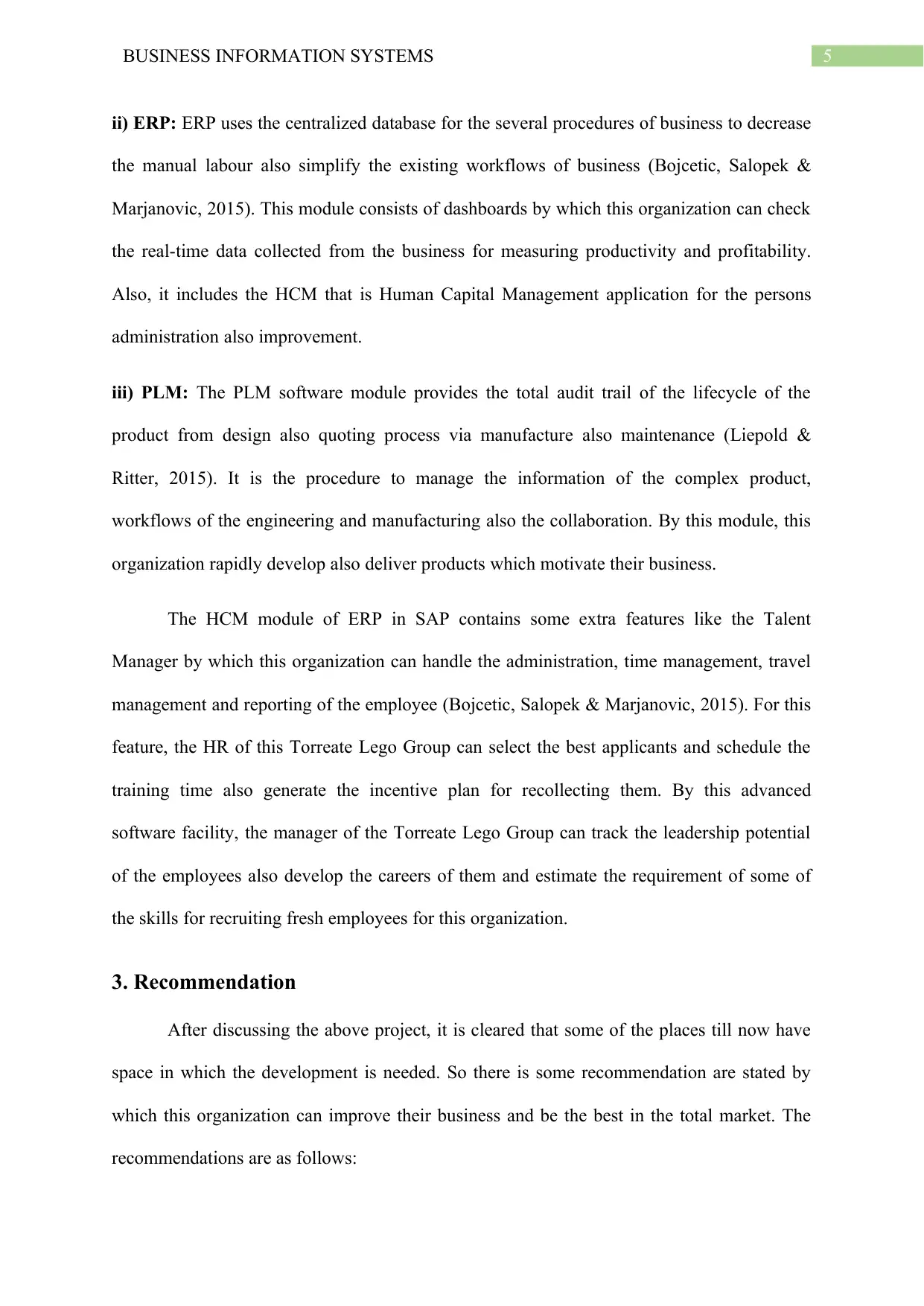
5BUSINESS INFORMATION SYSTEMS
ii) ERP: ERP uses the centralized database for the several procedures of business to decrease
the manual labour also simplify the existing workflows of business (Bojcetic, Salopek &
Marjanovic, 2015). This module consists of dashboards by which this organization can check
the real-time data collected from the business for measuring productivity and profitability.
Also, it includes the HCM that is Human Capital Management application for the persons
administration also improvement.
iii) PLM: The PLM software module provides the total audit trail of the lifecycle of the
product from design also quoting process via manufacture also maintenance (Liepold &
Ritter, 2015). It is the procedure to manage the information of the complex product,
workflows of the engineering and manufacturing also the collaboration. By this module, this
organization rapidly develop also deliver products which motivate their business.
The HCM module of ERP in SAP contains some extra features like the Talent
Manager by which this organization can handle the administration, time management, travel
management and reporting of the employee (Bojcetic, Salopek & Marjanovic, 2015). For this
feature, the HR of this Torreate Lego Group can select the best applicants and schedule the
training time also generate the incentive plan for recollecting them. By this advanced
software facility, the manager of the Torreate Lego Group can track the leadership potential
of the employees also develop the careers of them and estimate the requirement of some of
the skills for recruiting fresh employees for this organization.
3. Recommendation
After discussing the above project, it is cleared that some of the places till now have
space in which the development is needed. So there is some recommendation are stated by
which this organization can improve their business and be the best in the total market. The
recommendations are as follows:
ii) ERP: ERP uses the centralized database for the several procedures of business to decrease
the manual labour also simplify the existing workflows of business (Bojcetic, Salopek &
Marjanovic, 2015). This module consists of dashboards by which this organization can check
the real-time data collected from the business for measuring productivity and profitability.
Also, it includes the HCM that is Human Capital Management application for the persons
administration also improvement.
iii) PLM: The PLM software module provides the total audit trail of the lifecycle of the
product from design also quoting process via manufacture also maintenance (Liepold &
Ritter, 2015). It is the procedure to manage the information of the complex product,
workflows of the engineering and manufacturing also the collaboration. By this module, this
organization rapidly develop also deliver products which motivate their business.
The HCM module of ERP in SAP contains some extra features like the Talent
Manager by which this organization can handle the administration, time management, travel
management and reporting of the employee (Bojcetic, Salopek & Marjanovic, 2015). For this
feature, the HR of this Torreate Lego Group can select the best applicants and schedule the
training time also generate the incentive plan for recollecting them. By this advanced
software facility, the manager of the Torreate Lego Group can track the leadership potential
of the employees also develop the careers of them and estimate the requirement of some of
the skills for recruiting fresh employees for this organization.
3. Recommendation
After discussing the above project, it is cleared that some of the places till now have
space in which the development is needed. So there is some recommendation are stated by
which this organization can improve their business and be the best in the total market. The
recommendations are as follows:
⊘ This is a preview!⊘
Do you want full access?
Subscribe today to unlock all pages.

Trusted by 1+ million students worldwide
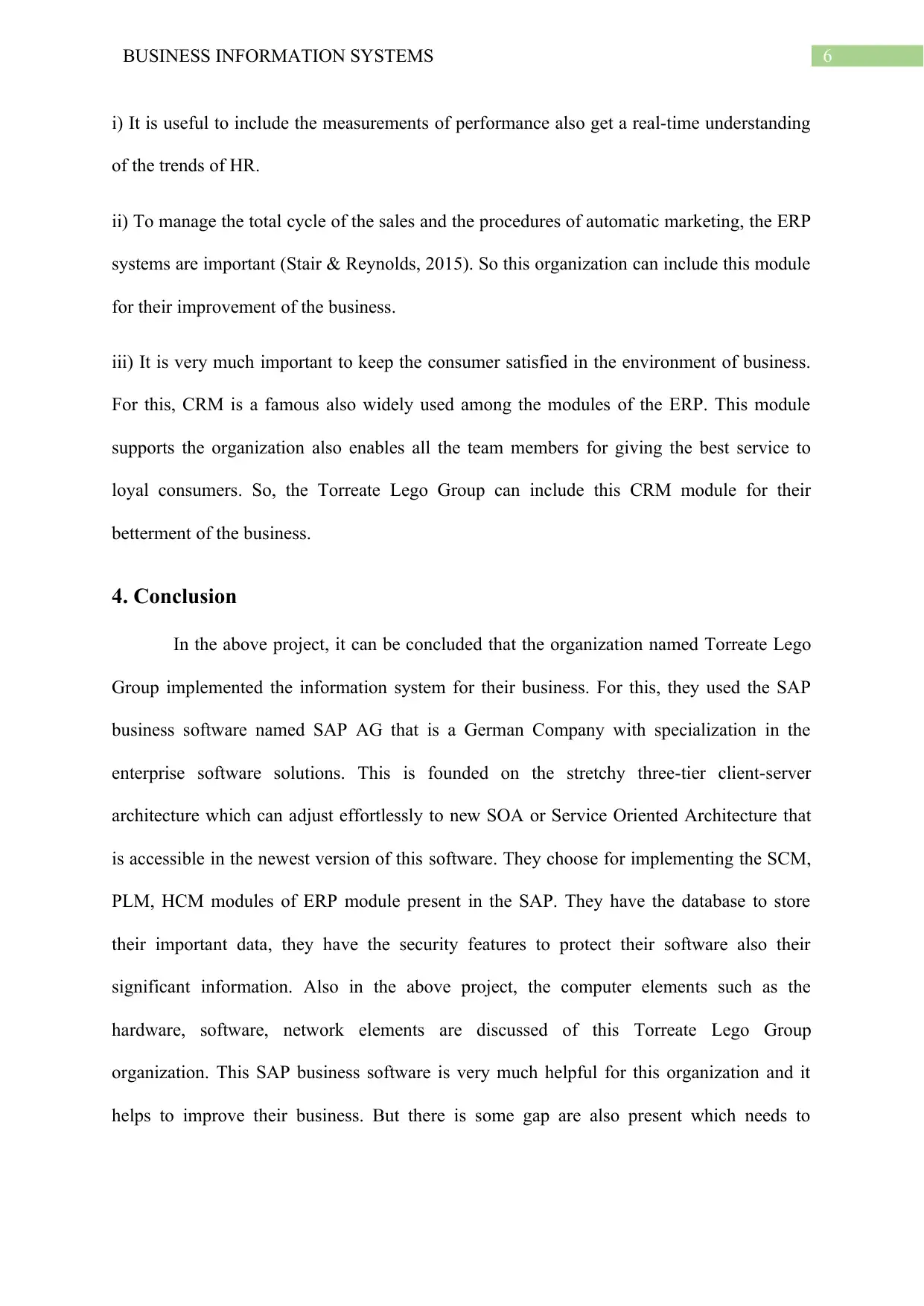
6BUSINESS INFORMATION SYSTEMS
i) It is useful to include the measurements of performance also get a real-time understanding
of the trends of HR.
ii) To manage the total cycle of the sales and the procedures of automatic marketing, the ERP
systems are important (Stair & Reynolds, 2015). So this organization can include this module
for their improvement of the business.
iii) It is very much important to keep the consumer satisfied in the environment of business.
For this, CRM is a famous also widely used among the modules of the ERP. This module
supports the organization also enables all the team members for giving the best service to
loyal consumers. So, the Torreate Lego Group can include this CRM module for their
betterment of the business.
4. Conclusion
In the above project, it can be concluded that the organization named Torreate Lego
Group implemented the information system for their business. For this, they used the SAP
business software named SAP AG that is a German Company with specialization in the
enterprise software solutions. This is founded on the stretchy three-tier client-server
architecture which can adjust effortlessly to new SOA or Service Oriented Architecture that
is accessible in the newest version of this software. They choose for implementing the SCM,
PLM, HCM modules of ERP module present in the SAP. They have the database to store
their important data, they have the security features to protect their software also their
significant information. Also in the above project, the computer elements such as the
hardware, software, network elements are discussed of this Torreate Lego Group
organization. This SAP business software is very much helpful for this organization and it
helps to improve their business. But there is some gap are also present which needs to
i) It is useful to include the measurements of performance also get a real-time understanding
of the trends of HR.
ii) To manage the total cycle of the sales and the procedures of automatic marketing, the ERP
systems are important (Stair & Reynolds, 2015). So this organization can include this module
for their improvement of the business.
iii) It is very much important to keep the consumer satisfied in the environment of business.
For this, CRM is a famous also widely used among the modules of the ERP. This module
supports the organization also enables all the team members for giving the best service to
loyal consumers. So, the Torreate Lego Group can include this CRM module for their
betterment of the business.
4. Conclusion
In the above project, it can be concluded that the organization named Torreate Lego
Group implemented the information system for their business. For this, they used the SAP
business software named SAP AG that is a German Company with specialization in the
enterprise software solutions. This is founded on the stretchy three-tier client-server
architecture which can adjust effortlessly to new SOA or Service Oriented Architecture that
is accessible in the newest version of this software. They choose for implementing the SCM,
PLM, HCM modules of ERP module present in the SAP. They have the database to store
their important data, they have the security features to protect their software also their
significant information. Also in the above project, the computer elements such as the
hardware, software, network elements are discussed of this Torreate Lego Group
organization. This SAP business software is very much helpful for this organization and it
helps to improve their business. But there is some gap are also present which needs to
Paraphrase This Document
Need a fresh take? Get an instant paraphrase of this document with our AI Paraphraser
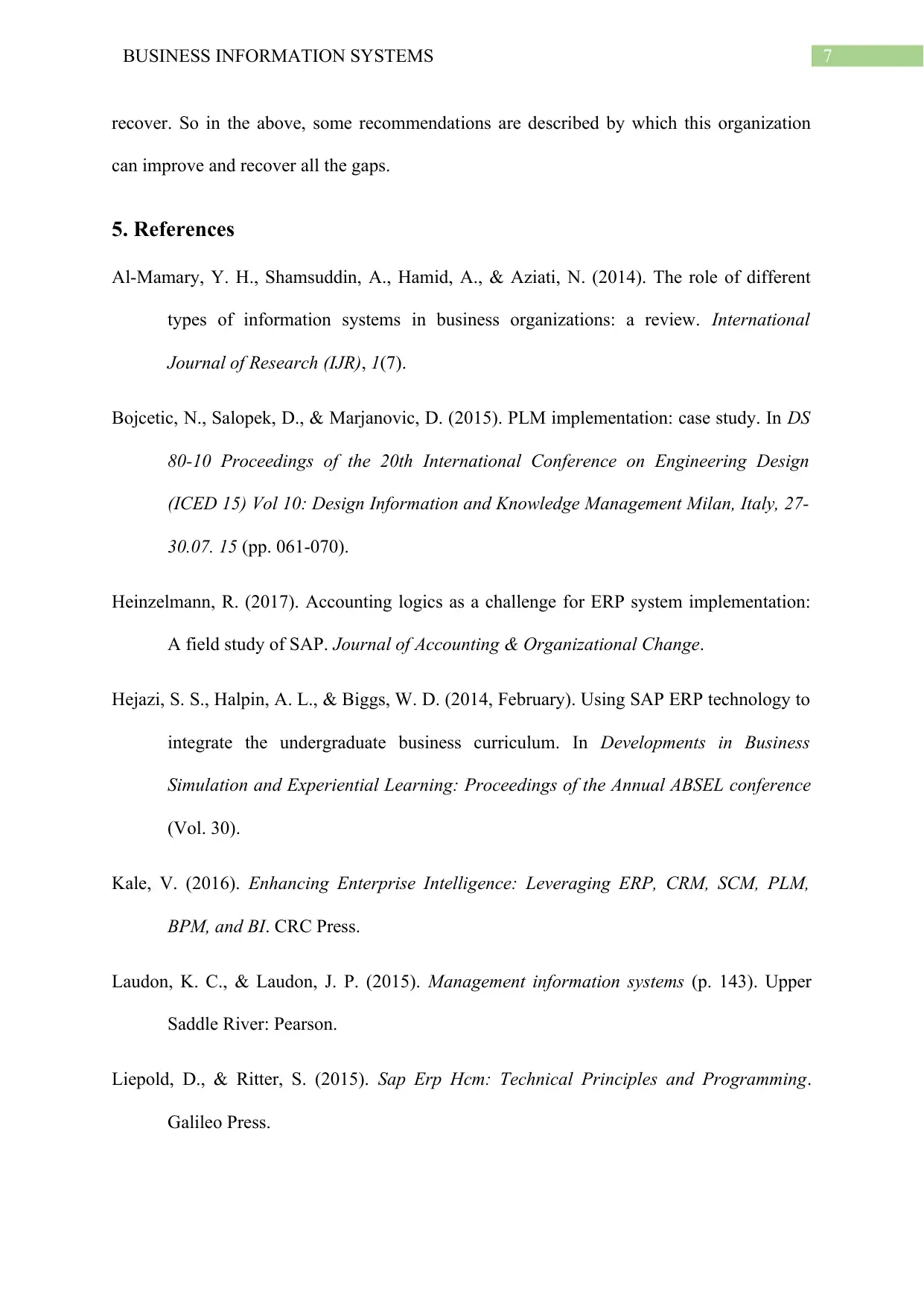
7BUSINESS INFORMATION SYSTEMS
recover. So in the above, some recommendations are described by which this organization
can improve and recover all the gaps.
5. References
Al-Mamary, Y. H., Shamsuddin, A., Hamid, A., & Aziati, N. (2014). The role of different
types of information systems in business organizations: a review. International
Journal of Research (IJR), 1(7).
Bojcetic, N., Salopek, D., & Marjanovic, D. (2015). PLM implementation: case study. In DS
80-10 Proceedings of the 20th International Conference on Engineering Design
(ICED 15) Vol 10: Design Information and Knowledge Management Milan, Italy, 27-
30.07. 15 (pp. 061-070).
Heinzelmann, R. (2017). Accounting logics as a challenge for ERP system implementation:
A field study of SAP. Journal of Accounting & Organizational Change.
Hejazi, S. S., Halpin, A. L., & Biggs, W. D. (2014, February). Using SAP ERP technology to
integrate the undergraduate business curriculum. In Developments in Business
Simulation and Experiential Learning: Proceedings of the Annual ABSEL conference
(Vol. 30).
Kale, V. (2016). Enhancing Enterprise Intelligence: Leveraging ERP, CRM, SCM, PLM,
BPM, and BI. CRC Press.
Laudon, K. C., & Laudon, J. P. (2015). Management information systems (p. 143). Upper
Saddle River: Pearson.
Liepold, D., & Ritter, S. (2015). Sap Erp Hcm: Technical Principles and Programming.
Galileo Press.
recover. So in the above, some recommendations are described by which this organization
can improve and recover all the gaps.
5. References
Al-Mamary, Y. H., Shamsuddin, A., Hamid, A., & Aziati, N. (2014). The role of different
types of information systems in business organizations: a review. International
Journal of Research (IJR), 1(7).
Bojcetic, N., Salopek, D., & Marjanovic, D. (2015). PLM implementation: case study. In DS
80-10 Proceedings of the 20th International Conference on Engineering Design
(ICED 15) Vol 10: Design Information and Knowledge Management Milan, Italy, 27-
30.07. 15 (pp. 061-070).
Heinzelmann, R. (2017). Accounting logics as a challenge for ERP system implementation:
A field study of SAP. Journal of Accounting & Organizational Change.
Hejazi, S. S., Halpin, A. L., & Biggs, W. D. (2014, February). Using SAP ERP technology to
integrate the undergraduate business curriculum. In Developments in Business
Simulation and Experiential Learning: Proceedings of the Annual ABSEL conference
(Vol. 30).
Kale, V. (2016). Enhancing Enterprise Intelligence: Leveraging ERP, CRM, SCM, PLM,
BPM, and BI. CRC Press.
Laudon, K. C., & Laudon, J. P. (2015). Management information systems (p. 143). Upper
Saddle River: Pearson.
Liepold, D., & Ritter, S. (2015). Sap Erp Hcm: Technical Principles and Programming.
Galileo Press.
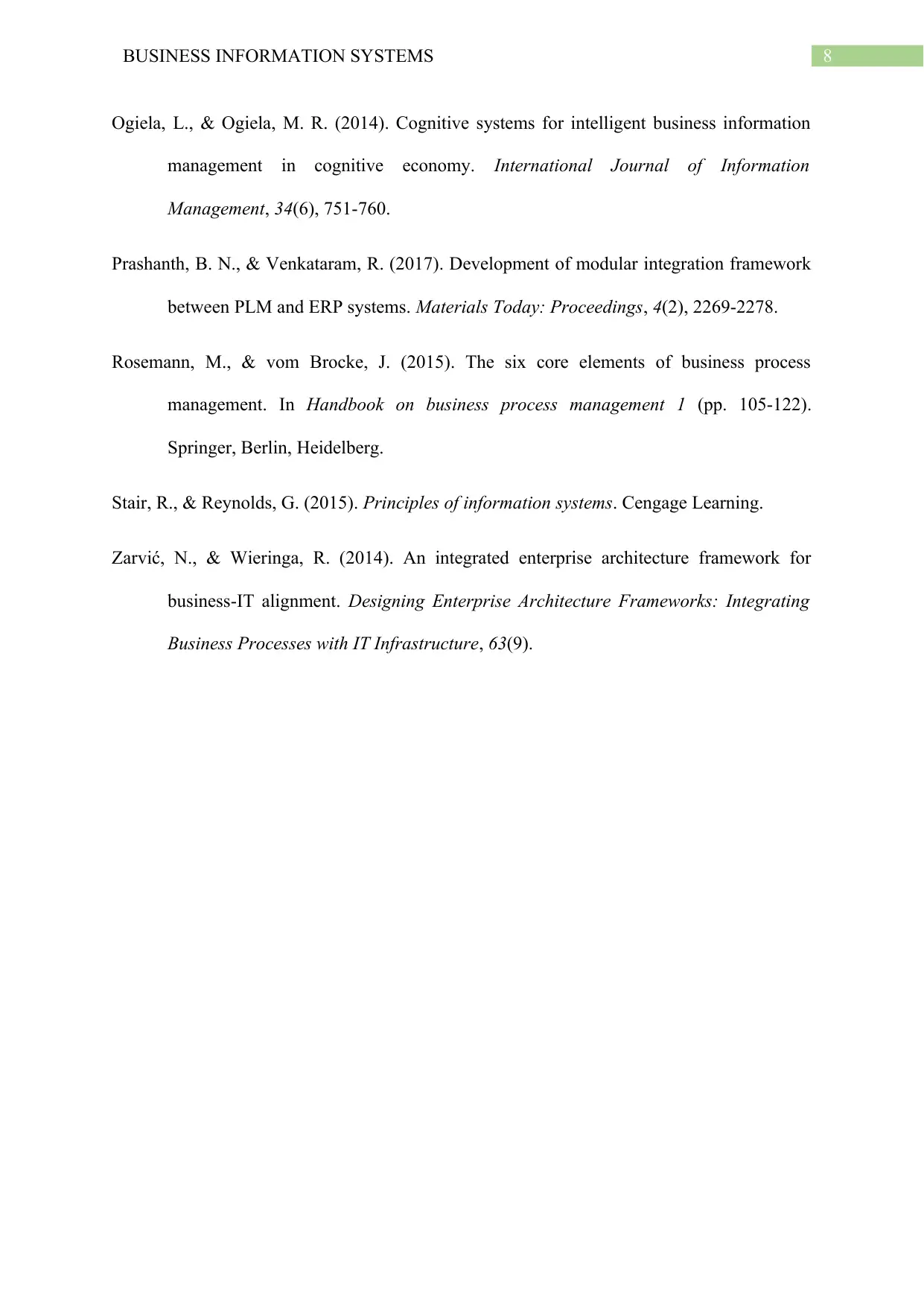
8BUSINESS INFORMATION SYSTEMS
Ogiela, L., & Ogiela, M. R. (2014). Cognitive systems for intelligent business information
management in cognitive economy. International Journal of Information
Management, 34(6), 751-760.
Prashanth, B. N., & Venkataram, R. (2017). Development of modular integration framework
between PLM and ERP systems. Materials Today: Proceedings, 4(2), 2269-2278.
Rosemann, M., & vom Brocke, J. (2015). The six core elements of business process
management. In Handbook on business process management 1 (pp. 105-122).
Springer, Berlin, Heidelberg.
Stair, R., & Reynolds, G. (2015). Principles of information systems. Cengage Learning.
Zarvić, N., & Wieringa, R. (2014). An integrated enterprise architecture framework for
business-IT alignment. Designing Enterprise Architecture Frameworks: Integrating
Business Processes with IT Infrastructure, 63(9).
Ogiela, L., & Ogiela, M. R. (2014). Cognitive systems for intelligent business information
management in cognitive economy. International Journal of Information
Management, 34(6), 751-760.
Prashanth, B. N., & Venkataram, R. (2017). Development of modular integration framework
between PLM and ERP systems. Materials Today: Proceedings, 4(2), 2269-2278.
Rosemann, M., & vom Brocke, J. (2015). The six core elements of business process
management. In Handbook on business process management 1 (pp. 105-122).
Springer, Berlin, Heidelberg.
Stair, R., & Reynolds, G. (2015). Principles of information systems. Cengage Learning.
Zarvić, N., & Wieringa, R. (2014). An integrated enterprise architecture framework for
business-IT alignment. Designing Enterprise Architecture Frameworks: Integrating
Business Processes with IT Infrastructure, 63(9).
⊘ This is a preview!⊘
Do you want full access?
Subscribe today to unlock all pages.

Trusted by 1+ million students worldwide
1 out of 9
Related Documents
Your All-in-One AI-Powered Toolkit for Academic Success.
+13062052269
info@desklib.com
Available 24*7 on WhatsApp / Email
![[object Object]](/_next/static/media/star-bottom.7253800d.svg)
Unlock your academic potential
Copyright © 2020–2025 A2Z Services. All Rights Reserved. Developed and managed by ZUCOL.





